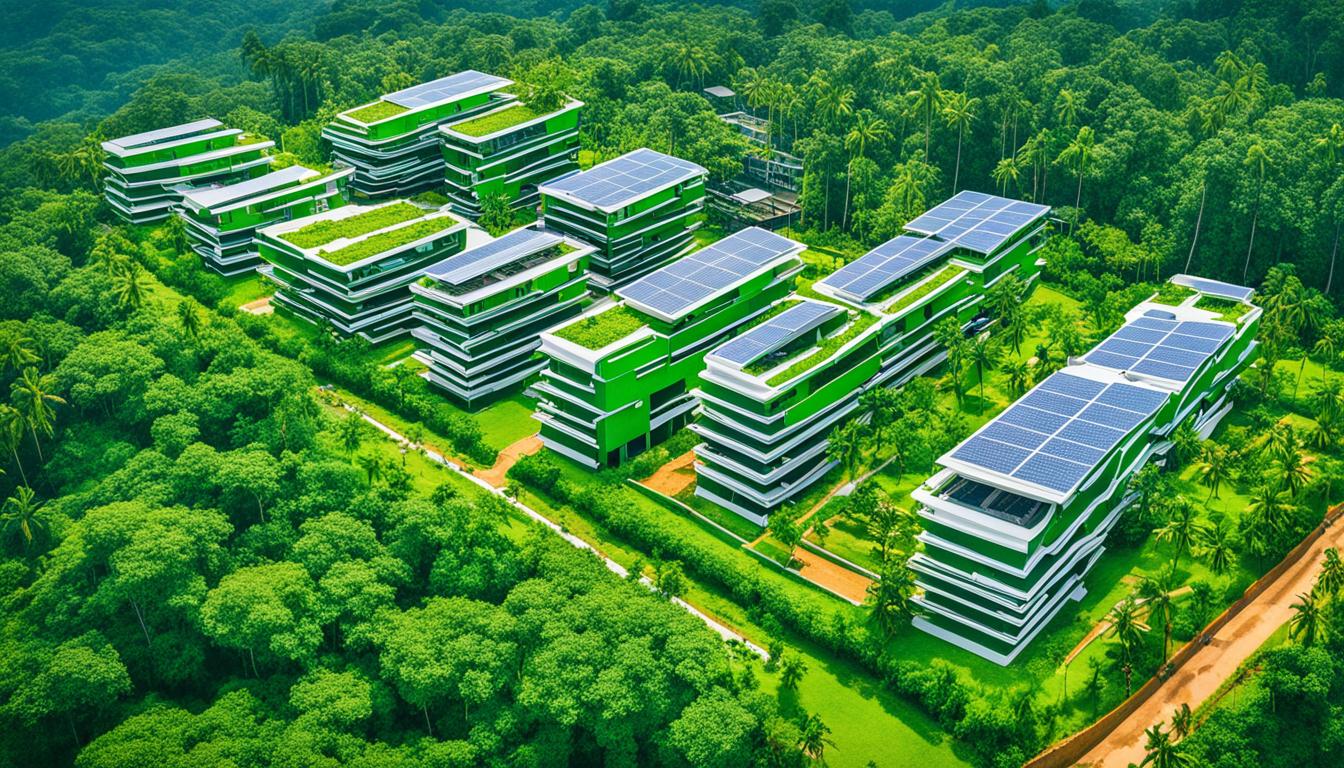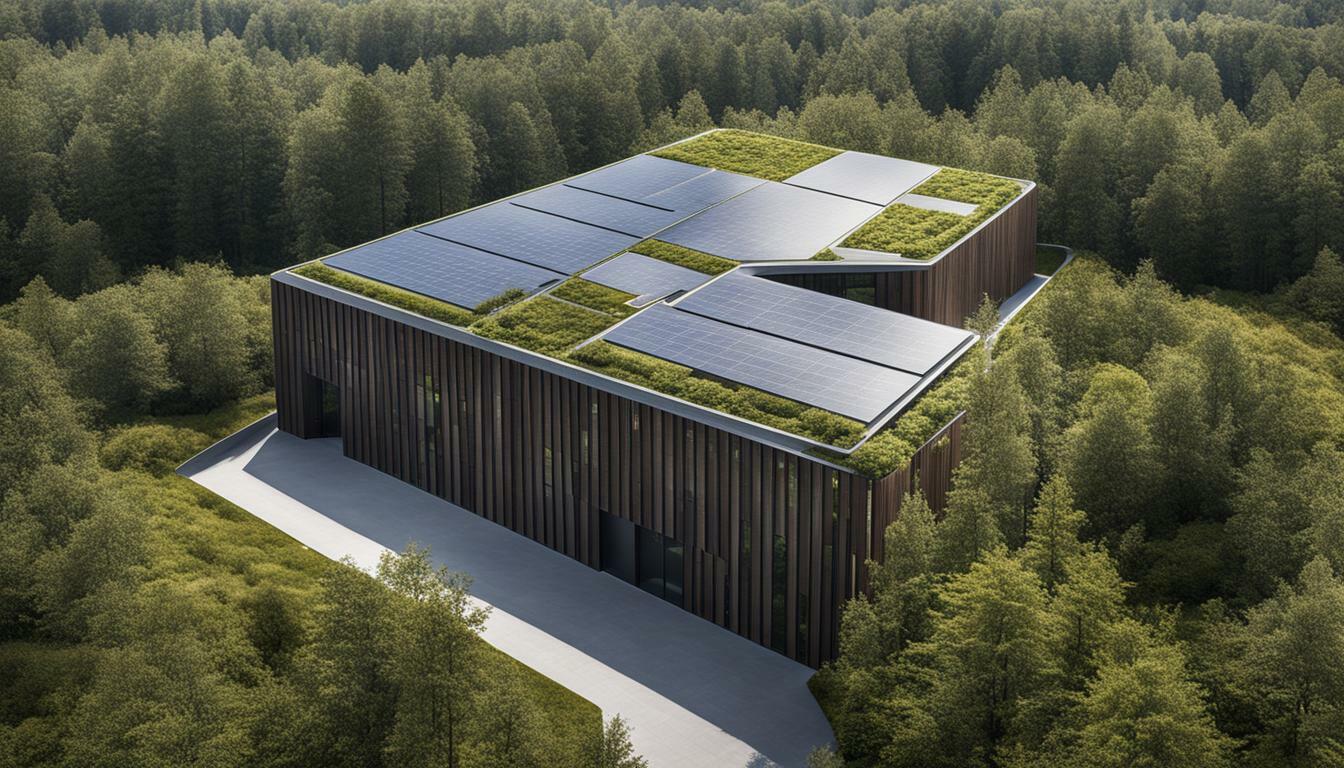Suriname Top Green Buildings
Welcome to the world of sustainable building design and eco-friendly architecture in Suriname. As one of the three carbon-negative countries on Earth, Suriname is leading the way in promoting environmental sustainability through its top green buildings. With a commitment to creating a greener future, Suriname is setting an example for the rest of the world.
Key Takeaways:
- Suriname is actively developing sustainable buildings to promote energy efficiency and environmental sustainability.
- The Port of Nickerie, developed by Van Aalst Marine & Offshore and the Phoenix Development Company, prioritizes green building practices.
- Suriname’s efforts in environmental sustainability extend beyond green building initiatives.
- Green buildings offer numerous benefits, including energy efficiency, improved air quality, and resource conservation.
- Suriname’s commitment to eco-friendly architecture positions it as an ideal destination for sustainable tourism.
Suriname’s Environmental Sustainability Efforts
Suriname, the most forested country in the world, is committed to environmental sustainability and sustainable development. With almost 93% of its land area covered by lush Amazon forests, the Republic of Suriname recognizes the importance of preserving its natural resources for future generations.
The country is actively working towards implementing the United Nations Sustainable Development Goals, which aim to address global challenges such as climate change, poverty, and inequality. Suriname’s efforts to promote environmental sustainability are multifaceted and encompass various areas, including:
- Forest Protection: Suriname recognizes the vital role of forests in mitigating climate change and preserving biodiversity. The country has implemented strict measures to protect its forests, ensuring their long-term sustainability.
- Mangrove Conservation: Suriname is actively involved in conserving mangroves, which serve as vital ecosystems for coastal areas. These mangroves provide numerous benefits, such as carbon sequestration, shoreline protection, and habitat for marine life.
- Eco-Friendly Practices: Suriname strives to promote sustainable practices across sectors, including energy, agriculture, and transportation. The country encourages the use of renewable energy sources, promotes sustainable farming techniques, and emphasizes the importance of eco-friendly transportation options.
Suriname’s commitment to environmental sustainability is not only crucial for the country itself but also has global significance. Preserving its natural resources and promoting sustainable development sets an example for other nations, inspiring them to take similar actions in their own contexts.
The integration of renewable energy sources is a key aspect of Suriname’s environmental sustainability efforts. By harnessing the power of solar, wind, and hydroelectric energy, the country aims to reduce dependence on fossil fuels and decrease carbon emissions.
Through these combined efforts, Suriname is shaping a greener and more sustainable future, demonstrating its dedication to environmental conservation and sustainable development.
Suriname’s Environmental Sustainability Statistics:
| Environmental Aspect | Statistics |
|---|---|
| Forest Coverage | Almost 93% of Suriname’s land area |
| Mangrove Conservation | Preservation of key mangrove ecosystems along the coast |
| Renewable Energy Integration | Increasing reliance on solar, wind, and hydroelectric energy sources |
Partnership for Green Building Development
In a concerted effort to prioritize green building practices and sustainable development, the partnership between Van Aalst Marine & Offshore, the Phoenix Development Company, and the government of Suriname is leading the development of the Port of Nickerie. This collaborative project aims to achieve LEED certification for the buildings within the port, ensuring that they meet rigorous standards for energy efficiency and sustainability.
The partnership is dedicated to creating a model for green building development in Suriname and driving the adoption of sustainable practices in the construction industry. By embracing green building principles, this initiative seeks to demonstrate the immense potential for environmentally conscious construction methods to positively impact Suriname’s future.
LEED certification, a globally recognized rating system for green buildings, emphasizes the implementation of sustainable design strategies, energy efficiency, and resource conservation. By striving for LEED certification in the Port of Nickerie, this partnership aims to set a new standard for green construction in Suriname and inspire future sustainable development across the country.
By combining the expertise of Van Aalst Marine & Offshore, the Phoenix Development Company, and the government of Suriname, this collaborative effort seeks to create a sustainable built environment that minimizes the impact on natural resources, reduces energy consumption, and promotes a healthier ecosystem. Through this partnership, Suriname is taking significant strides towards a greener and more sustainable future.
Sustainable Design Principles
The development of the Port of Nickerie will prioritize the use of green building materials, such as sustainable wood, recycled materials, and energy-efficient systems. By incorporating these materials and systems into the design, the buildings will not only have a minimal impact on the environment but also contribute to a greener future.
One of the key aspects of sustainable design is maximizing natural light and ventilation while minimizing energy consumption. By strategically placing windows, skylights, and ventilation systems, the buildings in the Port of Nickerie will optimize the use of natural resources, reducing the need for artificial lighting and air conditioning. This not only reduces energy consumption but also creates a healthier and more comfortable indoor environment for occupants.
In addition to passive design strategies, renewable energy sources will be integrated into the building design to further reduce carbon emissions. Solar panels, for example, can be installed on rooftops to generate clean energy and power the building’s electrical systems. This not only reduces reliance on traditional energy sources but also helps to mitigate the effects of climate change.
To showcase the sustainable design principles of the Port of Nickerie, the following table highlights the key features and materials that will be used:
| Key Features | Materials |
|---|---|
| Optimization of natural light and ventilation | Solar control glazing, window shading systems |
| Energy-efficient systems | LED lighting, high-efficiency HVAC systems |
| Renewable energy integration | Solar panels, wind turbines |
| Use of sustainable materials | Forest Stewardship Council (FSC) certified wood, recycled materials |
The combination of these sustainable design principles and the use of green building materials will contribute to the overall energy efficiency and environmental sustainability of the Port of Nickerie. By adopting these practices, Suriname takes a significant step towards creating a built environment that aligns with the principles of sustainability and sets an example for future development projects.
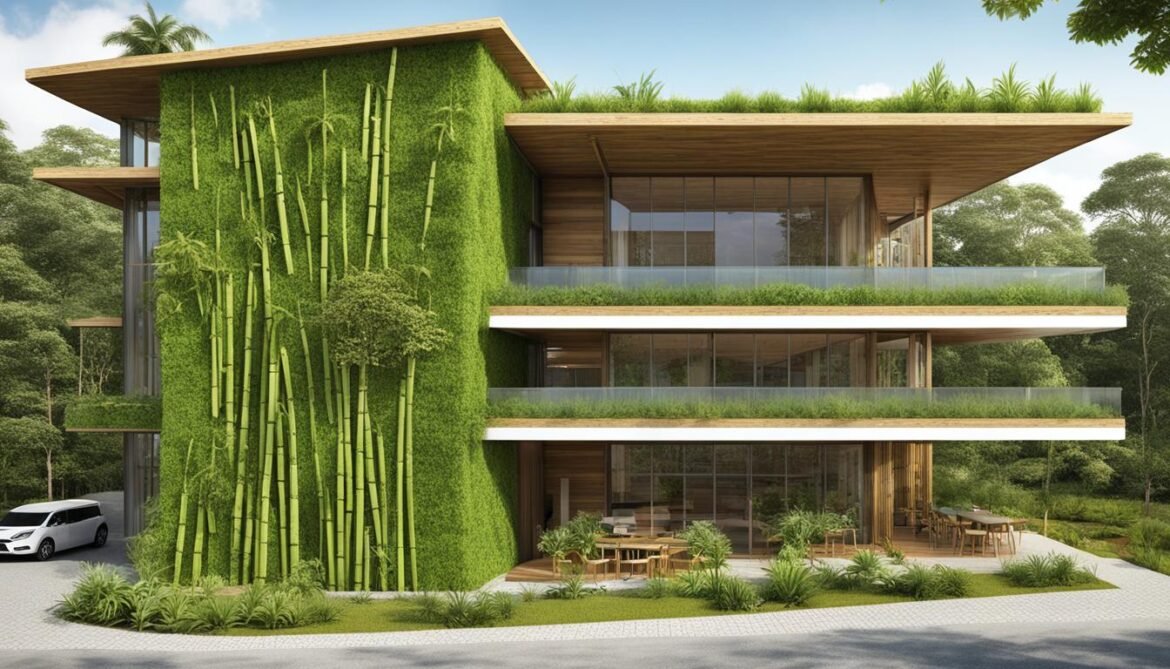
Benefits of Green Buildings
Green buildings offer numerous benefits, both for the environment and for the people who inhabit them. They promote energy efficiency, reducing the carbon footprint and lowering operating costs. Green buildings also provide healthier indoor environments, with improved air quality and natural lighting.
According to a study by Harvard T.H. Chan School of Public Health, occupants of green-certified buildings reported a 26% reduction in cognitive function issues compared to those in conventional buildings. The connection between sustainable building design and occupant well-being is increasingly recognized as a vital aspect of creating healthy living and working spaces.
Furthermore, green buildings contribute to the overall sustainability of the surrounding community. By utilizing sustainable building materials and implementing energy-efficient systems, these buildings conserve resources and minimize environmental impact. They also serve as models for environmental responsibility and inspire others to adopt eco-friendly architecture.
“Sustainable building design plays a crucial role in creating a greener future. By prioritizing energy efficiency and environmental sustainability, green buildings contribute to a healthier planet for future generations.”
Reduced Environmental Impact
- Energy Efficiency: Green buildings incorporate energy-efficient technologies and design strategies, such as insulation, solar panels, and energy-efficient appliances. These measures significantly reduce energy consumption and carbon emissions, mitigating the effects of climate change.
- Water Conservation: Sustainable building design includes features such as low-flow plumbing fixtures, rainwater harvesting systems, and native landscaping. These water-saving measures reduce water consumption and protect precious water resources.
- Waste Reduction: Green buildings prioritize waste reduction by incorporating recycling systems, using recycled materials, and implementing responsible construction practices. By reducing waste sent to landfills, these buildings contribute to a more sustainable waste management system.
Improved Indoor Environment
- Air Quality: Green buildings prioritize indoor air quality through proper ventilation systems, the use of low-emission building materials, and the removal of pollutants. This results in healthier and cleaner air for occupants, reducing the risk of respiratory issues.
- Natural Lighting: Green buildings are designed to maximize natural light, reducing the need for artificial lighting during daylight hours. This not only reduces energy consumption but also enhances occupants’ well-being, productivity, and connection to the natural environment.
- Comfort: Green buildings focus on providing thermal comfort, incorporating features such as proper insulation and efficient heating and cooling systems. By maintaining consistent indoor temperatures, these buildings create a comfortable living and working environment.
Financial Benefits
The benefits of green buildings extend beyond environmental and health advantages. They also offer financial benefits to building owners and occupants, including:
- Lower operational costs due to reduced energy and water consumption.
- Potential tax incentives and rebates for implementing sustainable building practices.
- Increased property value and marketability due to the growing demand for environmentally friendly buildings.
- Improved tenant satisfaction and productivity, leading to higher occupancy rates.
The incorporation of sustainable building design and eco-friendly architecture in Suriname’s development projects, such as the Port of Nickerie, will undoubtedly enhance the country’s environmental sustainability and contribute to a greener future.

Suriname’s Eco-Tourism Potential
Suriname, with its commitment to eco-friendly practices and an abundance of natural beauty, offers a unique destination for eco-tourism. The country’s top green buildings, alongside its pristine rainforests and diverse ecosystems, create an ideal setting for travelers seeking sustainable tourism options.
Suriname’s dedication to sustainable development is exemplified by its eco-friendly architecture and green building practices. These initiatives not only contribute to the preservation of its natural heritage but also drive economic growth in the country.
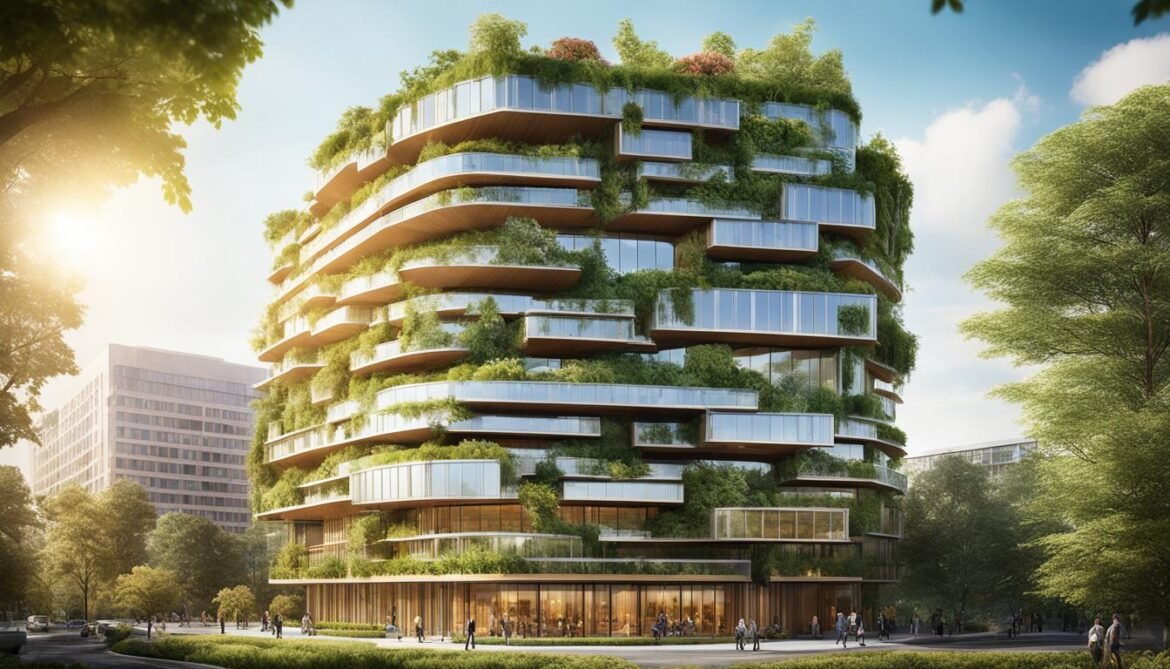
Suriname’s eco-tourism potential lies in its harmonious blend of sustainable development, green building practices, and breathtaking natural landscapes. It offers a truly immersive experience for conscious travelers who value environmentally responsible choices.
By promoting eco-friendly architecture and sustainable building practices, Suriname not only attracts tourists but also sets an inspiring example for other countries to follow. The preservation of its natural beauty ensures a greener future for generations to come.
Key Features of Suriname’s Eco-Tourism Potential:
- Top green buildings that showcase eco-friendly architecture
- Pristine rainforests and diverse ecosystems
- Sustainable development initiatives
- Opportunities for sustainable tourism
Suriname’s commitment to sustainable development and eco-friendly practices makes it a must-visit destination for environmentally conscious travelers.
Suriname’s Green Building Initiatives
Suriname is committed to promoting sustainable building design and green building practices throughout the country. One of the major projects leading this initiative is the development of the Port of Nickerie. This project not only showcases Suriname’s dedication to sustainable development but also serves as a flagship project for green building practices.
In collaboration with private companies, the Surinamese government is actively working towards creating a sustainable built environment. The focus is on prioritizing energy efficiency, environmental sustainability, and the use of renewable resources in construction.
By implementing green building practices, Suriname aims to reduce the carbon footprint, conserve energy, and create healthier living spaces for its citizens. This commitment to sustainable building design aligns with Suriname’s goal of becoming a global leader in eco-friendly architecture and sustainable development.
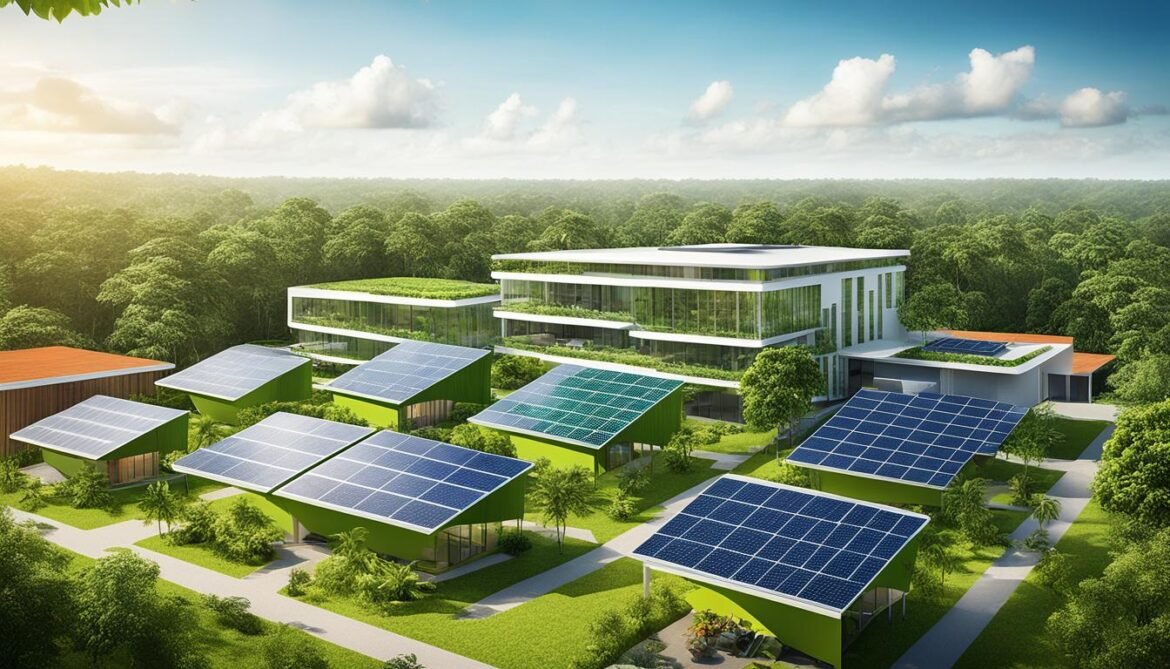
Benefits of Suriname’s Green Building Initiatives
The green building initiatives in Suriname offer numerous benefits in terms of environmental preservation, economic growth, and community well-being. Some of the key advantages include:
- Promotion of energy efficiency and reduction in carbon emissions.
- Enhancement of indoor air quality and occupant health.
- Conservation of natural resources through sustainable construction practices.
- Stimulation of economic growth through the development of eco-friendly architecture.
- Creation of a sustainable living environment for present and future generations.
The development of the Port of Nickerie and other green building projects in Suriname not only contribute to the country’s environmental goals but also inspire other nations to adopt similar sustainable practices. Suriname’s commitment to green building initiatives sets a positive example and promotes a greener and more sustainable future.
Suriname’s Green Building Initiatives: A Comparative Overview
| Country | Green Building Initiatives |
|---|---|
| Suriname | Development of the Port of Nickerie with a focus on sustainable design and construction |
| Country X | Minimal green building practices with limited emphasis on energy efficiency and environmental sustainability |
| Country Y | Extensive integration of renewable energy sources in building design, offering a highly sustainable built environment |
| Country Z | Green building regulations and certifications to ensure energy-efficient and environmentally friendly construction |
“Suriname’s green building initiatives showcase the country’s commitment to sustainable development and eco-friendly architecture. The Port of Nickerie project serves as a benchmark for green building practices, reflecting Suriname’s dedication to creating a sustainable built environment.” – [Name], Sustainable Building Expert
Suriname’s Role in Global Conservation Efforts
Suriname, as one of the most forested countries in the world, is committed to environmental sustainability and plays a significant role in global conservation efforts. The nation’s dedication to renewable energy integration, forest preservation, and sustainable development sets an inspiring example for other countries to follow.
“Suriname’s commitment to conserving its natural resources is commendable. As a country blessed with abundant forests, Suriname’s efforts in protecting these valuable ecosystems contribute greatly to global conservation initiatives.”
– Environmental expert, Dr. Elizabeth Greenfield
Suriname’s green building initiatives also contribute to its overall conservation efforts. By promoting sustainable construction practices and integrating renewable energy sources, Suriname aims to reduce its carbon footprint and create environmentally-friendly buildings.
Suriname’s dedication to environmental sustainability is not only beneficial for the country itself but also positions Suriname as a leader in sustainable development on the global stage. By showcasing the importance of preserving natural resources and embracing eco-friendly practices, Suriname inspires other nations to prioritize environmental conservation.
Suriname’s Key Contributions to Global Conservation:
- Preservation of forest ecosystems
- Integration of renewable energy sources
- Promotion of sustainable development practices
- Leadership in sustainable architecture and green building initiatives
Suriname’s commitment to environmental sustainability and renewable energy integration is not only relevant for the nation itself but also crucial for the future of our planet. By prioritizing global conservation efforts, Suriname sets an example for other countries and paves the way for a greener and more sustainable world.
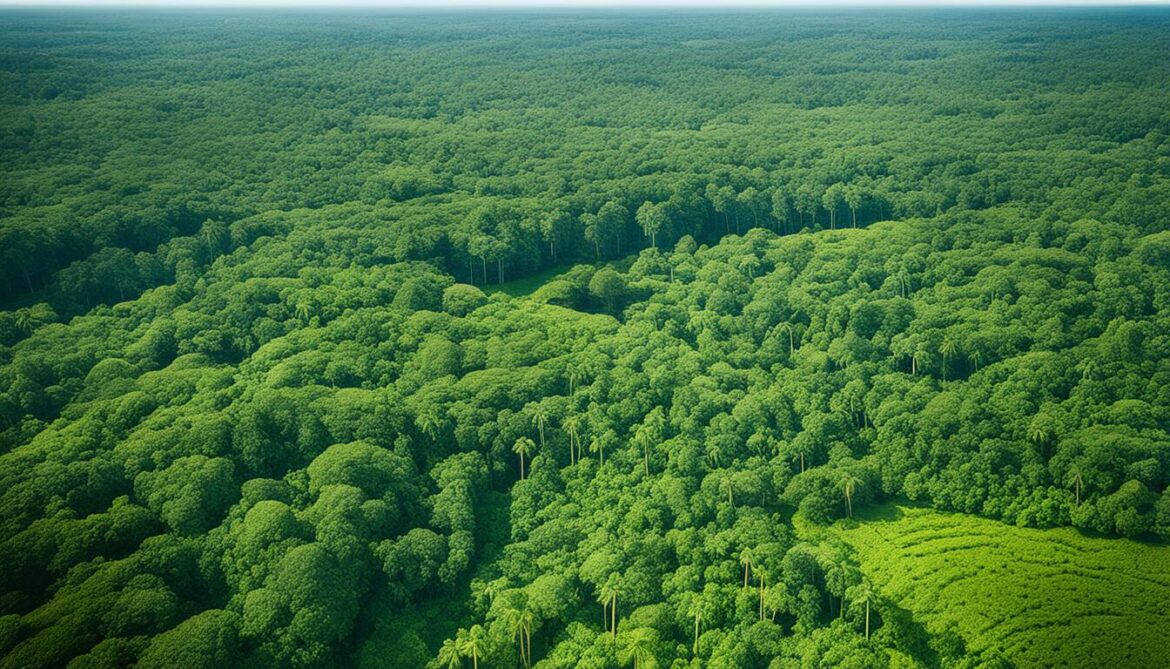
Next Up: Suriname’s Eco-Tourism Potential
Conclusion
Suriname’s top green buildings demonstrate the nation’s unwavering commitment to sustainable development and eco-friendly architecture. The collaborative partnership between Van Aalst Marine & Offshore, the Phoenix Development Company, and the government of Suriname is a shining example of collective efforts towards building a greener future. With its vast forests, incredible eco-tourism potential, and progressive initiatives in green building practices, Suriname continues to lead the way in environmental sustainability. The ongoing development of the Port of Nickerie, alongside other green building projects across the country, will undoubtedly shape Suriname’s sustainable future.
The Suriname Top Green Buildings showcase the innovative integration of sustainable design principles, employing eco-friendly materials and energy-efficient construction. These buildings not only reduce their carbon footprint but also create healthier indoor environments with improved air quality and natural lighting. Moreover, they contribute to overall community sustainability by conserving resources and promoting environmentally responsible practices. Suriname’s dedication to eco-friendly architecture will inspire others to adopt similar practices and drive positive change in the industry.
Suriname’s commitment to eco-friendly practices extends beyond its borders, as it plays a crucial role in global conservation efforts. With its rich and diverse forest coverage, Suriname acts as a guardian of the environment, actively preserving its natural heritage and promoting sustainable development. The country’s green building initiatives complement its overall conservation goals and position Suriname as a global leader in sustainable practices. By embracing renewable energy integration, forest preservation, and sustainable development, Suriname serves as an inspiring example for nations striving for a greener and more sustainable future.




